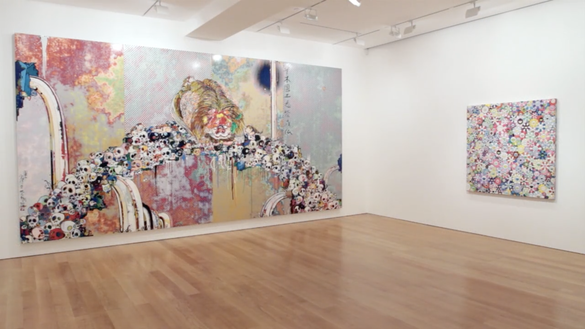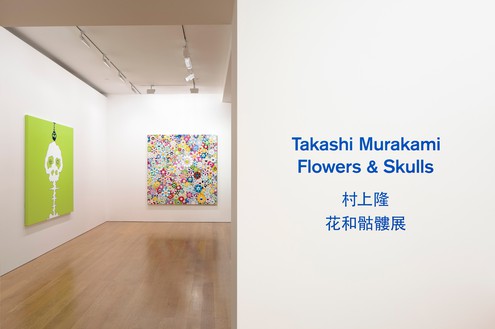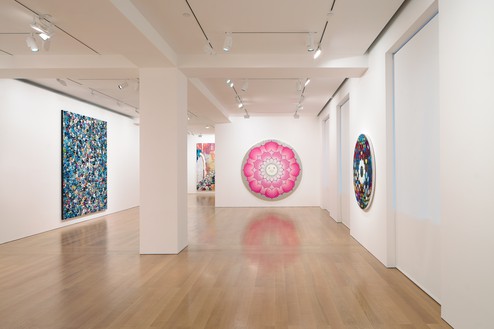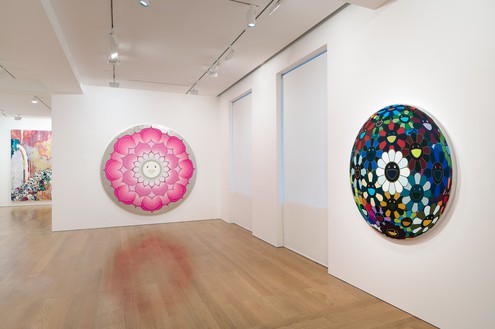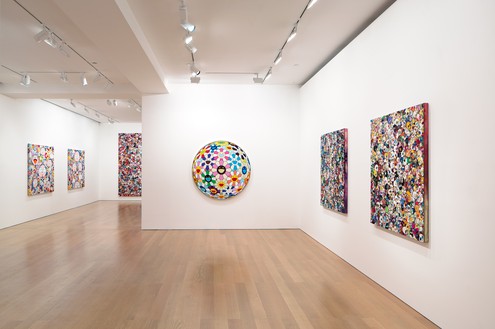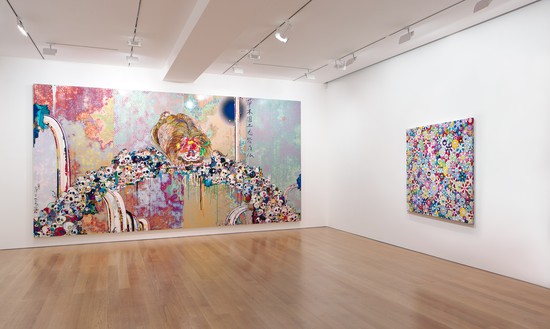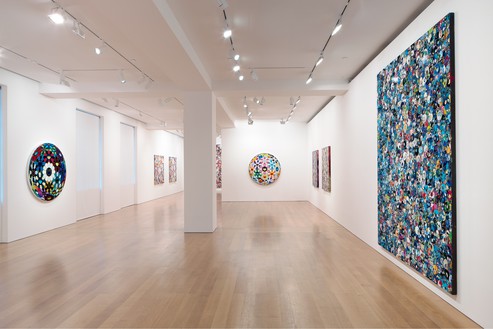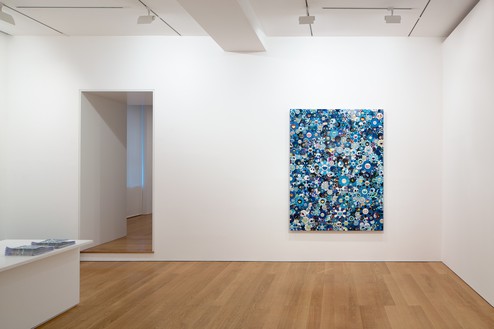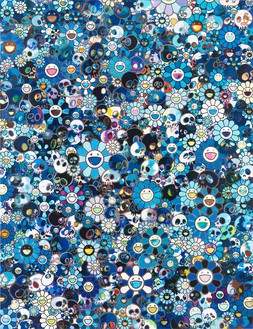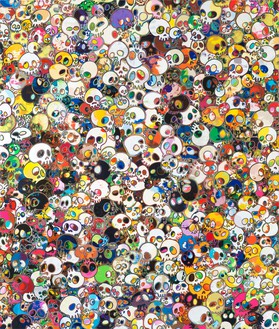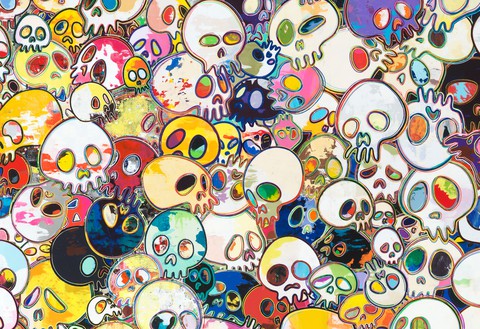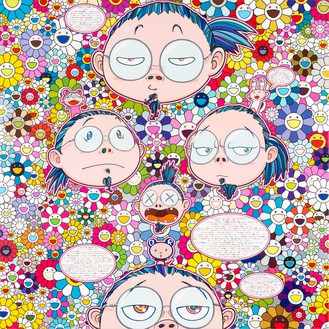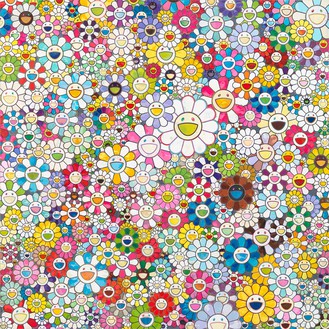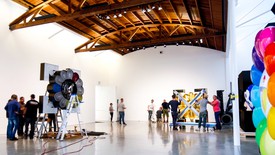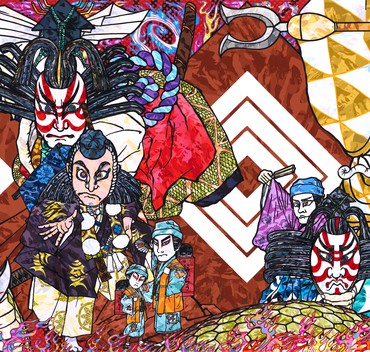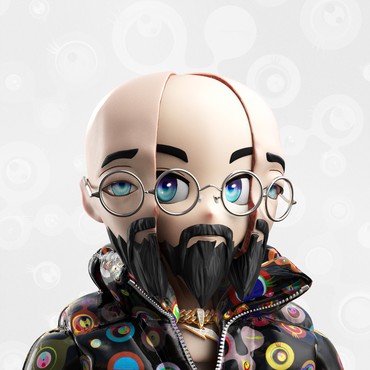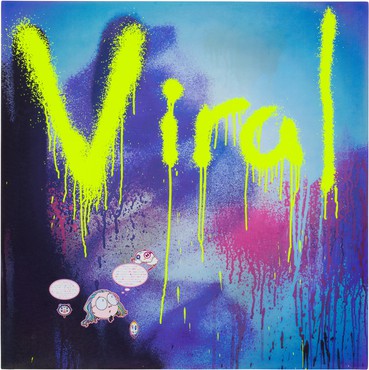About
What is Art?
For those of us born in Asia, it remains an ever-important question. The reason is that what we today define as Art represents the path followed by Western art history, and yet here in the East, we have our own history. To survive as artists, we must learn to resolve the collision of these two cultures.
My own personal position is drawn from how well I can arrange the unique flowers of Asia, moreover the ever strange blossoms that have bloomed in the madness of the defeated culture of postwar Japan, into work that will live within the confines of Western art history.
—Takashi Murakami
This exhibition, Takashi Murakami’s first in Hong Kong, explores one of the central dichotomies of his art—between joy and terror, his optimistic magnanimity as an artist and his pessimistic perspective on postwar Japan. Here, this dichotomy is symbolized by the stark contrast of bright smiling flowers and disturbing, menacing representations of skulls. Whether depicted as single iconic “portraits” or in complex clusters of virtuoso composition and paintwork that combine painstaking traditional artisanal techniques with the pop and fizz of manga, the flower and the skull stand as eternal motifs in the history of art and popular culture. Both oppositional and parallel, they are reminders of the fragile vibrancy of life and the inexorable passing of time.
A lightning rod between different cultural valencies (high/low, ancient/modern, oriental/occidental), Murakami has stated that the artist is someone who understands the borders between worlds and who makes an effort to know them. With his distinctive “Superflat” style and ethos, which employs highly refined classical Japanese painting techniques to depict a super-charged mix of Pop, anime, and otaku content within a flattened representational picture-plane, he moves freely within an ever-expanding field of aesthetic issues and cultural inspirations. Parallel to utopian and dystopian themes, he recollects and revitalizes narratives of transcendence and enlightenment, often involving outsider-savants. Mining religious and secular subjects favored by the so-called Japanese “eccentrics,” nonconformist artists of the Early Modern era commonly considered to be counterparts to the Western Romantic tradition, Murakami situates himself within their legacy of bold and lively individualism in a manner that is entirely his own and of his time.
甚麼是藝術?
對於我們生於亞洲的一群來說,這向來是個非常重要的問題
因我們現今定義的「藝術」,只代表了西方美術史走的路,然而在東方這邊,我們也有自
己的歷史。作為藝術家若要求存,就必須學習緩解這兩種文化之間的衝擊。
我的個人立場,是要把亞洲獨特的繁花,以至在戰後日本文化崩潰的瘋狂中冒起的奇葩們
好好編配起來,使之成為能夠在西方美術史的規限中存活的作品
—村上隆
是次展覽-村上隆在香港的首個展覽-主要探索他藝術裡其中一項最重要的二分法:愉快 與驚駭、作為藝術家的樂觀寬容與對戰後日本的悲觀看法,由笑容燦爛的花朵與邪惡可怕 的骷髗頭像之間的強烈對比作象徵。無論是標誌性的單一「肖像」,抑或以群集形式出現 ,運用到大師級繪畫與構圖技巧,揉合了精細傳統工藝與通俗肥皂泡漫畫的複雜建構,花 與骷髏頭在美術史和流行文化裡都是永恆的主題。它們的性質既相反,亦相似,令人聯想 到生命的脆弱與時光飛逝之無情
村上隆曾說過,藝術家是了解不同世界之間的界線並努力去搞懂它的人,就如不同文化價 值之間的「避雷針」(高尚/低俗、古代/現代、東方/西方) 憑著其招牌「超級扁平 《Superflat》風格和精神,村上隆以精煉的古典日本畫技巧,在扁平化的圖像空間裡,將 流行、動漫與御宅族內容混合成一種感覺超豐富的意象,所涉獵的美學領域和文化靈感不 斷延伸,而他在當中游走自如。一如常見的烏托邦與敵托邦主題,他喚醒、活化了有關超 越與啟蒙的敘述,時而涉及外人學者。他所開發的宗教與世俗主題,向來就深受現代時期 之初被喻為日本「奇人」或反傳統藝術家的喜愛,這常被視為跟西方浪漫派傳統相呼應 村上隆把自己置身於他們大膽、熱烈的個人主義遺蔭裡,展現出的姿態卻是完全屬於他本 人和他的時代的
Share
Artist
Downloads

In Conversation
Takashi Murakami and Hans Ulrich Obrist
Hans Ulrich Obrist interviews the artist on the occasion of his 2012 exhibition Takashi Murakami: Flowers & Skulls at Gagosian, Hong Kong.
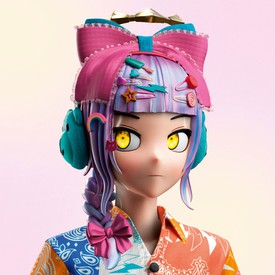
Takashi Murakami and RTFKT: An Arrow through History
Bridging the digital and the physical realms, the three-part presentation of paintings and sculptures that make up Takashi Murakami: An Arrow through History at Gagosian, New York, builds on the ongoing collaboration between the artist and RTFKT Studios. Here, Murakami and the RTFKT team explain the collaborative process, the necessity of cognitive revolution, the metaverse, and the future of art to the Quarterly’s Wyatt Allgeier.
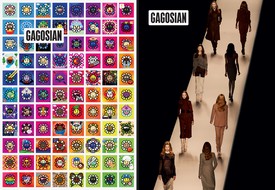
Now available
Gagosian Quarterly Summer 2022
The Summer 2022 issue of Gagosian Quarterly is now available, with two different covers—featuring Takashi Murakami’s 108 Bonnō MURAKAMI.FLOWERS (2022) and Andreas Gursky’s V & R II (2022).
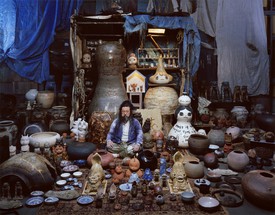
Murakami on Ceramics
Takashi Murakami writes about his commitment to the work of Japanese ceramic artists associated with the seikatsu kōgei, or lifestyle crafts, movement.
Takashi Murakami at LACMA
In a conversation recorded at the Los Angeles County Museum of Art, Takashi Murakami describes the process behind three major large-scale paintings, including Qinghua (2019), inspired by the motifs painted on a Chinese Yuan Dynasty porcelain vase.
“AMERICA TOO”
Join us for an exclusive look at the installation and opening reception of Murakami & Abloh: “AMERICA TOO”.
